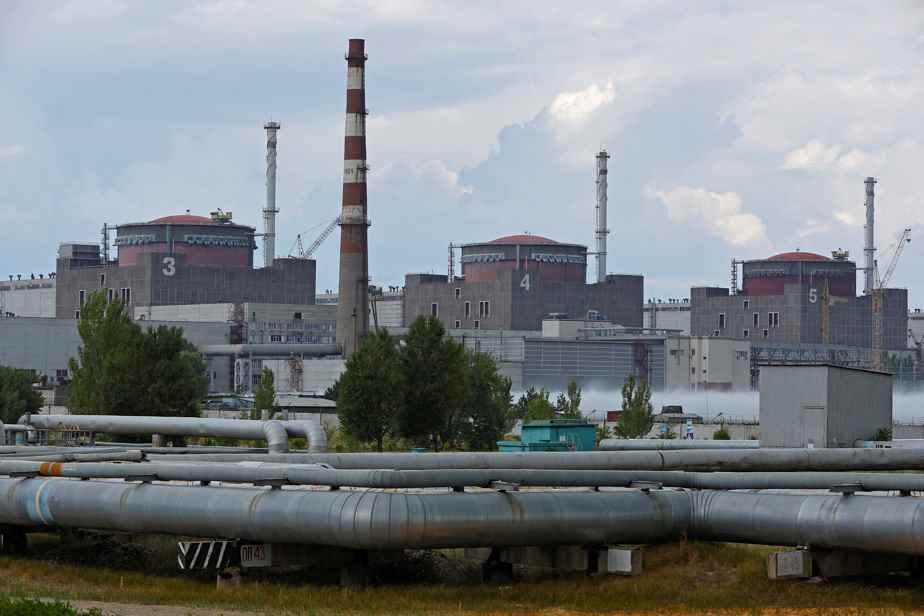(Vyshchetarasivka) Anastasia Rudenko clutches the gold medal her husband Viktor received for working as a “liquidator” after the Chernobyl nuclear disaster. He died in 2014 of bladder cancer, a consequence she says of radiation.
Posted at 8:01 a.m.
In his village of Vyshchetarassivka, a handful of kilometers from the Zaporijjia nuclear power plant, Mme Roudenko is now working to have the role of radiation in the death of her husband recognized.

PHOTO BULENT KILIC, AGENCE FRANCE-PRESSE
Anastasia Roudenko preparing melons in her garden
On the other side of the river, barely 14 kilometers away, it is impossible not to see the imposing silhouette of the power station.
Since August 5, Kyiv and Moscow have accused each other of bombing. The strikes once landed near a radioactive storage building, and another time caused the automatic shutdown of Reactor No. 3 at Europe’s largest nuclear power plant.
Ukraine claims that Moscow is launching attacks and stockpiling weapons and soldiers near the plant, taking advantage of the Ukrainian army’s inability to retaliate.
“We could meet the same fate as the inhabitants of Chernobyl”, sighs Mme Rudenko, 63 years old. “Nothing good is happening and we don’t know how it will end.”
In the zone ”
Ukraine remains deeply marked by the Chernobyl nuclear disaster in northern Ukraine in April 1986. A reactor exploded, causing the largest civilian nuclear accident in history and releasing a radioactive cloud which spread all over Europe.

PHOTO VOLODYMYR REPIK, ASSOCIATED PRESS ARCHIVES
Aerial view of the Chernobyl nuclear power plant in 1986
In four years, 600,000 “liquidators” have been dispatched to the scene with little or no protection to put out the fire and clean up the surrounding territories.
The human toll of the disaster is still debated. The UN recognizes only about thirty dead among operators and firefighters killed by acute radiation just after the explosion, when the anti-nuclear NGO Greenpeace estimated in 2006 at 100,000 the number of deaths.
Viktor Rudenko drove a truck through “the zone” for 18 days. A gold ribbon was awarded to him by the Soviet Union, showing atoms revolving around the “Chernobyl bell”, a symbol of the place.
A document in poor condition, from the archives of the Ukrainian Ministry of Defense, certifies Viktor’s work and the dose of radiation he absorbed: 24.80 roentgen.
“When I see my husband’s papers, I feel pain,” says Anastasia Roudenko: “Many people have died or been injured forever.”
Referring to the bombings on the site of the plant, visible from her home, she says that “people say that there are leaks, but they avoid admitting it publicly”.
Living “Liquidators”
At the start of the invasion of Ukraine, Russian troops also seized the Chernobyl power plant, which is still in operation, but the premises were abandoned a few weeks later, when the failure to take Kyiv prompted Moscow to withdraw its soldiers.
The Zaporijjia power plant was also occupied from the first days of the war, after brief fighting which had already created fear. It has since remained in Russian hands: the Dnipro River traces the boundary between the territories occupied by Moscow and those in the hands of Kyiv.
Vassyl Davidov affirms that three “liquidators” still live in Vychtchetarassivka, a bucolic set of small cabins with an unobstructed view of the river, immense at this place, and in the distance on the cooling towers of the power station.

PHOTO BULENT KILIC, AGENCE FRANCE-PRESSE
Vassyl Davidov chats with his wife.
He is one of them: he spent three and a half months working on the decontamination of Chernobyl, making 102 trips to the “zone”, using a dosimeter to measure radiation levels while he razed contaminated houses .
In his garden, on a freezer transformed into a makeshift table, the 65-year-old man unpacks his medals. One of them represents the mythological figure of Atlas holding the world, the image of the terrestrial globe replaced by the Chernobyl power station.

PHOTO BULENT KILIC, AGENCE FRANCE-PRESSE
Documents and photos belonging to Vassyl Davidov
There are also pictures. Of Vassyl Davidov in military uniform, posing with comrades in front of a sign declaring “Soldier! We are going to bring Chernobyl soil back to life. »
” I was there. I saw everything, and I saw the extent” of the damage, assures Mr. Davidov.
It takes more to scare him. A few days after the plant was taken by Russian troops in March, iodine tablets were distributed in the village in case of emergency, but the time spent in “the zone” seems to have accustomed it to the threat.
“If you believe everything you’re told, it’s enough to drive you crazy,” he smiles: “So you use your experience as a filter. What will fear do to me? How could she help me? »
